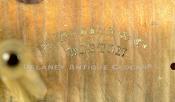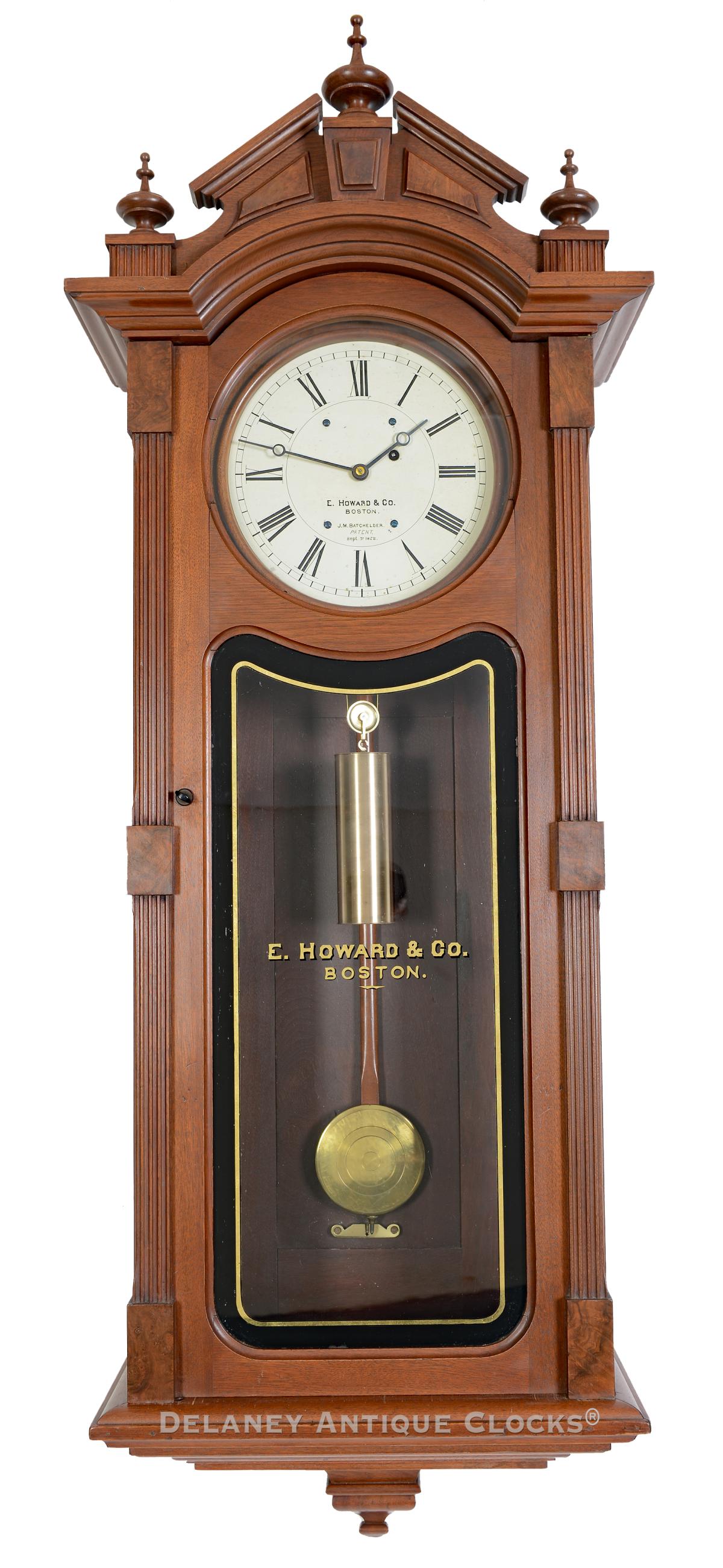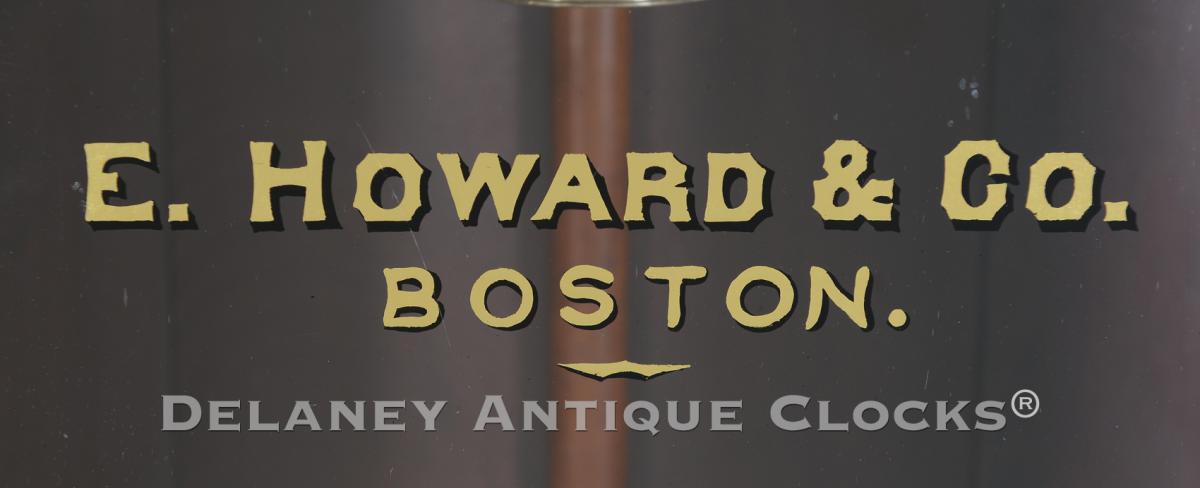E. Howard & Co. The Number 60 Special wall clock advertising J. M. BATCHELDER's SEPTEMBER 3, 1872 Patent. 223323.
The E. Howard Clock Company should be well known for constructing custom-ordered clocks. There are numerous entries in the available Howard shop records for special movements for cataloged models and custom cases to be built per design in their factory. Hezikiah Conant of Pawtucket, Rhode Island, contracted the Howard Clock Company to build speed indicators and complicated regulators of his design. The regulators featured two and a four pendulum models. Numerous architects submitted plans to construct their case designs around Howard’s mechanisms. Howard was even willing to send his components to competing case-making firms. All in the course of doing business.
Two similarly designed custom Howard clocks were recently sold in the marketplace in the same year. Both clocks are constructed in walnut and share a similar case form but differ in dimensions.
The first clock was sold at auction in New Hampshire in 2023. This wall clock briefly caught our attention. We make a point to look at any clock made by the E. Howard Company. This large wall clock featured a glass painted” OFFICAL / RAILWAY / CERTIFIED / TIME / UNION STATION / DENVER.” Denver’s Union Station opened for the first time on June 1, 1881. On March 18, 1894, an electrical fire consumed the central hall and clock tower. The Depot was quickly rebuilt. Two decades later, the city of Denver had decided it had outgrown the station, and work began on a grand new vision.
Clocks associated with the railroads are always popular with collectors. The added interest can elevate the value of a standard example. This was a big clock, measuring 65.5 inches long, 29 inches wide, and 11 inches deep. Unfortunately, it did not have the most graceful proportions. It was stalky, having the proportions of an out-of-shape wrestler. The cabinet was very deep to accommodate the brass mounting standoff to which the movement was attached. The movement featured an unusual formatting. Both plates were rectangular shaped, but the front plate was a third longer than the back. Something was missing. At the time, we did not understand why it was constructed in that manner. Shortly after that, we purchased a similar clock that shared the primary form of the Denver Union Station clock. The second example was an improved version of the first and is being offered here.
The movements of both clocks shared the same unusual design. These clocks differed in their overall proportions. The second example is much sleeker and, as a result, more attractive. It is approximately 60 inches long, 21,25 inches wide, and 10.5 inches deep. Both clocks were made in black walnut, but this clock included the addition of burl walnut veneer highlights. These were applied to the three raised panels incorporated in the crest and on the blocking featured in the design of the columns. Another additional construction detail worth noting is the long oval-shaped windows on the sides of this case. (The first clock had solid sides.) These windows light up the inside of the case, reducing the shadows. Both clocks used the same movement. The lower glass on this clock is paint-decorated from the back in black and gold. The company name, “E. Howard & Co. / BOSTON.” is lettered across the middle. The 10-inch diameter painted dial is signed, “J. M. BATCHELDER / PATENT / SEPTEMBER 3 / 1872.” It would seem that including the patent date would be helpful in dating when these clocks were made. It also suggests that it was used before Howard’s association with J. Hamblet, Jr., who was referenced in their 1874 catalog.
John Montgomery Batchelder was born on October 13, 1811, in New Ipswich, New Hampshire. His parents were Samuel and Mary Batchelder. He was a student at Brunswick University, now Bowdoin College, in 1831, and he went on to study civil engineering with Professor Haywood at Harvard. Batchelder worked at the York Mills in Maine, the Lawrence Mills, and at a mill in Ipswich, MA. He was very well respected in the field and was recruited to work with J. E. Hilgard and Joseph Saxton on the United States Coast Guard Survey testing baseline apparatus. In 1858, Batchelder was detailed from the coast survey to assist Dr. B. A. Gould in the Dudley Observatory at Albany. He was employed to bring the calculating machine into shape and to aid in arranging the telegraphic connections and apparatus.
At Harvard University, he was a contemporary of Agassiz, Wyman, Bond, Gibbs, and Gould. All contributed to making the university the center of science. Before 1853, he invented the Bunsen burner. The US Navy and the English Navy used his apparatus for deep-sea soundings. Much of his work centered around the transmitting of signals underwater. He also was fascinated with electricity. He and Moses Farmer invented the compound telegraph wire. Batchelder created the vulcanite insulator used to string electrical wire on poles. His electromagnetic watch clocks were often made by the E, Howard Clock Co. It is used in safety deposit vaults. Other inventions include vulcanite plate electric machines, tide gauge hydrometers, pressure sounding machines, cards for people who are blind, card catalogs for the library, porcelain and iron insulators, and railway starting signals. His activity was remarkable. He was elected a Fellow of the American Academy of the Arts and Sciences in 1866. He was a member of the Boston Society of Natural History, the Boston Society of the Arts, the American Association for the Advancement of Science, the American Institute of New York, and the Natural History Society of Portland, Maine.
John was granted several patents. One for a ruler was granted on June 18, 1872, and one for an electromagnetic watch clock, No. 130,971, on September 3, 1872.
He is listed in the 1870 federal census as living in Cambridge and working as a civil engineer.
He died on July 2, 1892, in Cambridge, MA, and is buried in the Mount Auburn Cemetery.
Both clocks must have had Batchedler's patented electromagnetic watch-clock apparatus, which is now missing. The Howard records reveal that they sold many watch clocks and used designs by J Hamblet Jr, Batchelder, and others. Some of the orders specify which system to use.
The E. Howard Clock Company made this Vienna-style regulator called the Model 60 Special, a rare clock, circa 1872. It is a testament to bespoke craftsmanship and precision horology. This exceptional timepiece, a result of a special order, showcases the company's dedication to constructing unique cases beyond its standard catalog offerings. The hallmark of E. Howard's reputation is that these special order cases demonstrate their willingness to collaborate with architects and accommodate custom designs around their renowned clock mechanisms.
Its large case, crafted from black walnut with an original finish, is stunning. The pediment top, paneled with lively figured walnut and adorned with three finely turned finials, adds a touch of elegance. Fluted columns featuring inset-figured walnut panels flank the sides of the clock's door. The original lower glass, paint-decorated from the back in black and gold, proudly displays the company name, "E. Howard & Co. / BOSTON," across the middle.
The 13 3/4-inch diameter painted zinc dial, framed with a wooden trim ring, bears the maker's original block signature. The dial also features the inscription "J. M. BATCHELDER / PATENT / SEPT. 3rd / 1872," providing a glimpse into the clock's historical significance. Open moon hands gracefully indicate the time, while behind the dial, a seasoned cherry pendulum rod is visible through the glass door. The 4.5-inch diameter bob, zinc-covered in brass and finished in nickel, features an intricate engine-turned design of concentric circles.
The clock's eight-day duration weight-driven movement, constructed in brass, attests to its superior quality. The recoil escapement ensures accurate timekeeping. A nickeled weight descends within the case throughout the week, underscoring the clock's mechanical prowess.
This Vienna-style regulator is a tangible legacy of Edward Howard, a clockmaking virtuoso who began his journey as an apprentice, co-founded Howard & Davis, and ultimately established the renowned "E. Howard Clock Co., Boston," in 1857. As Edward Howard retired in 1882, this clock remains a testament to his commitment to excellence, innovation, and the timeless artistry that defines the E. Howard Clock Company. Today, this timepiece serves as a symbol of the golden age of American clockmaking.
John Montgomery Batchelder was born on October 13, 1811, in New Ipswich, New Hampshire. He was a student at Brunswick University, now Bowdoin College, in 1831 and studied civil engineering at Harvard. Much of his work centered around the transmitting of signals underwater. He also was fascinated with electricity. He and Moses Farmer invented the compound telegraph wire. Batchelder created the vulcanite insulator used to string electrical wire on poles. He invented the electromagnetic watch clock, which the E, Howard Clock Co. produced. It was also used in safety deposit vaults. Other inventions include vulcanite plate electric machines, tide gauge hydrometers, pressure sounding machines, cards for blind people, card catalogs for the library, porcelain and iron insulators, and railway starting signals. His activity was remarkable.
This clock must have had Batchedler's patented electromagnetic watch-clock apparatus, which is now missing. The Howard records reveal that they sold many watch clocks and used designs by J. Hamblet Jr., Batchelder, and others. Some of the orders specify which system to use.
This case has dimensions of 60 inches high, 21.25 inches wide, and 10.25 inches deep.
Inventory number 223323.
The E. Howard & Company succeeded the Howard & Davis firm in 1857. The Howard & Davis firm was comprised of Edward Howard and David Porter Davis and was established in 1842 in Roxbury, Massachusetts. Both men had just completed their clock apprenticeship under the guidance of Aaron Willard Jr in Boston. The Howard & Davis firm made high-grade clocks, precision balances, sewing machines, fire engines, and watches. After the dissolution of Howard & Davis, Edward Howard became Boston's leading manufacturer of weight-driven residential and commercial clocks. The firm also made a large number of tower clocks and watchman and salve clock systems. These sold well in the last quarter of the 1800s.
It has been said that the E. Howard Clock company never made an inexpensive clock, and everything they made was of very good quality. As a result, Howard clocks have become very collectible and are prized by their owners. Today, the E. Howard name enjoys outstanding name recognition.
For a more in-depth reading of Edward Howard and his various businesses, please read "Willard's Patent Time Pieces," written by Paul Foley.
























